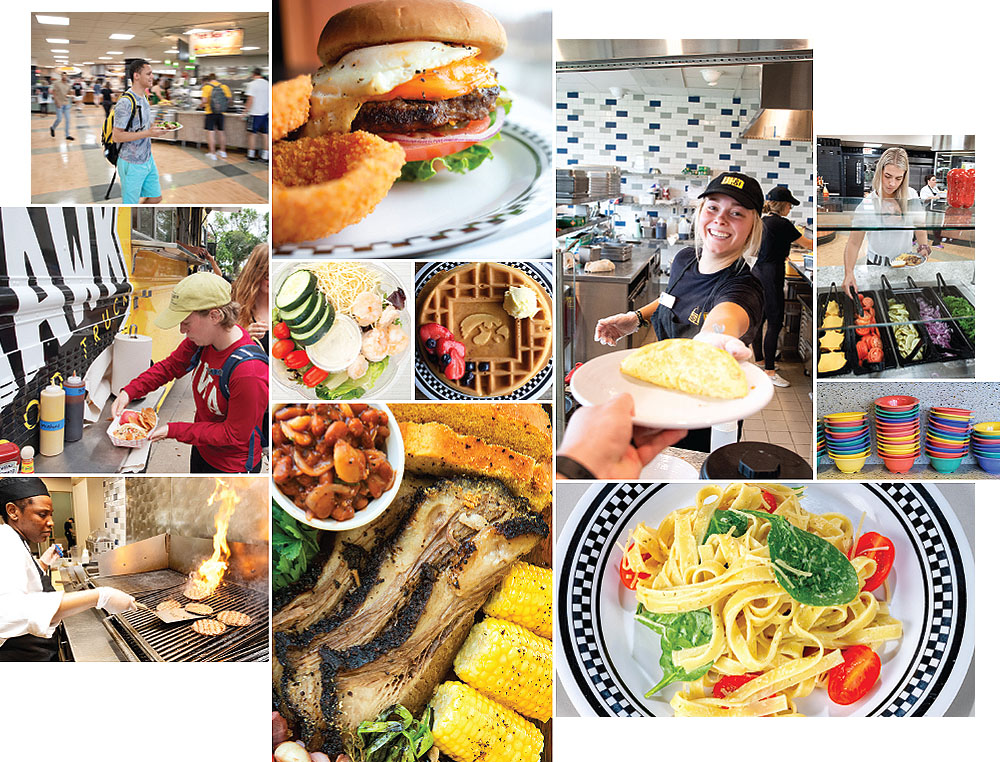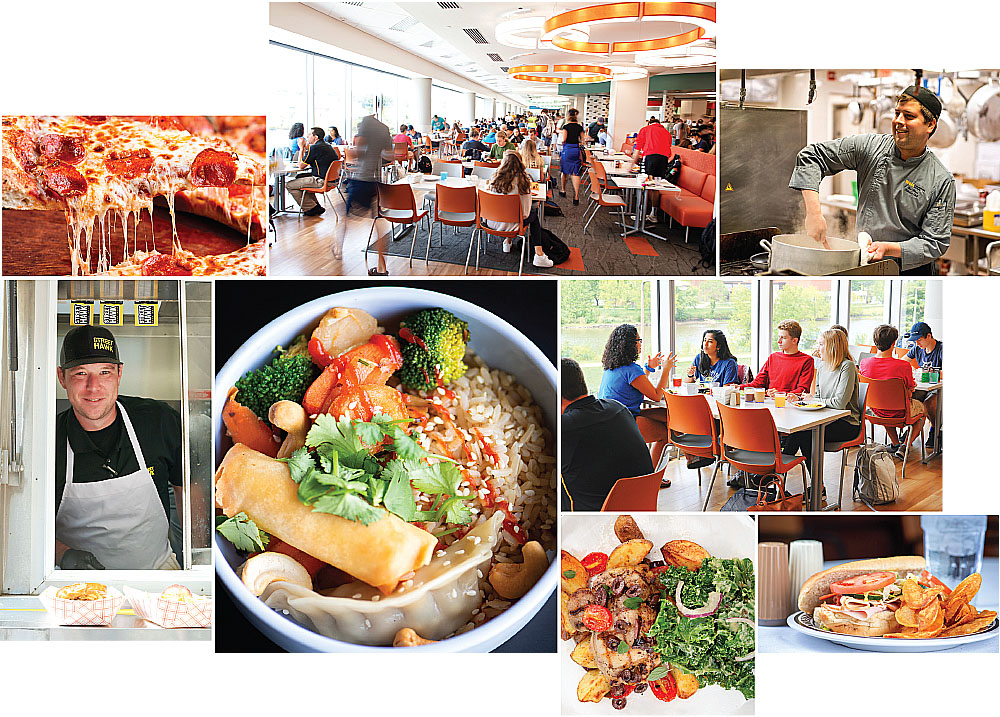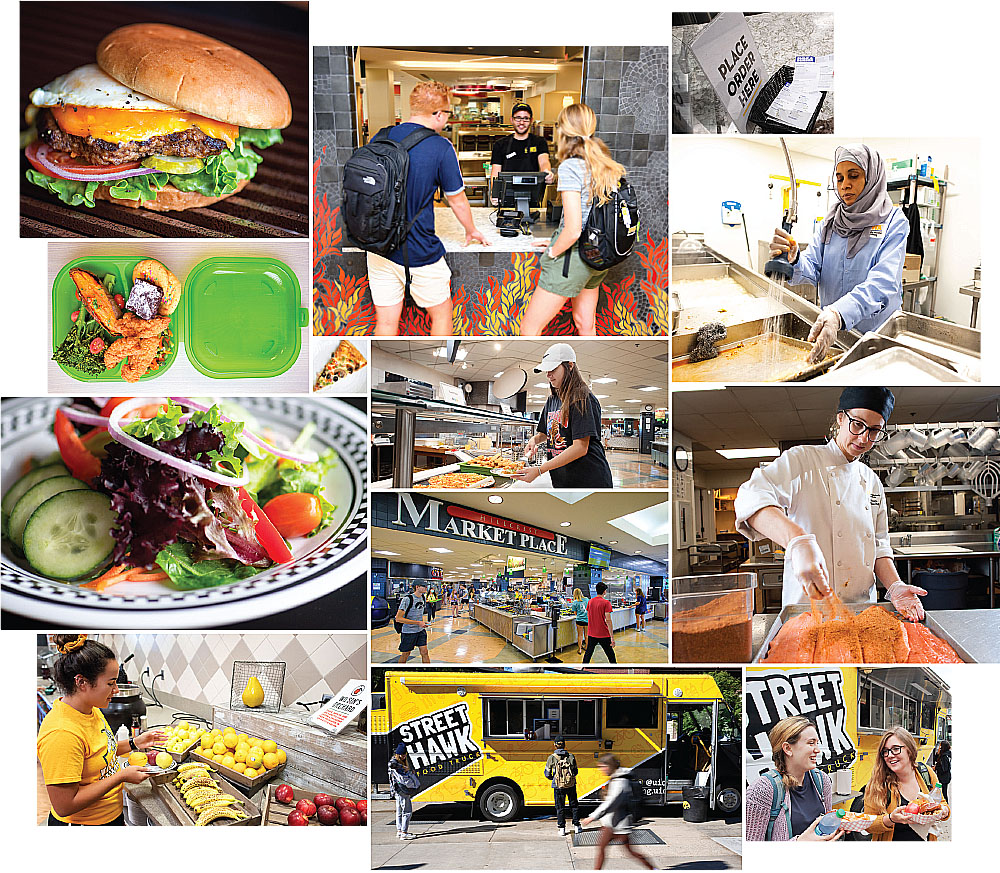For Iowa Students, These Aren't Their Parents' Dining Halls
 PHOTOS: Justin Torner
PHOTOS: Justin Torner
Feeding large groups of people is no small feat—just ask anyone who has tried to order pizza with friends. Compound that challenge to serving more than 900,000 meals over the course of a semester, and the task becomes herculean.
It’s a daunting undertaking, one that historically led to limited menus, long lines, and crowded spaces. But in recent years, University of Iowa Dining Services has taken that challenge head-on, using careful planning to add new locations, ingredients, and meal plans that cater to the needs of a diverse student body.
From the Street Hawk food truck’s on-the-go tacos to the allergy-free choices in Burge Market Place, here’s how today’s campus dining scene has become more sustainable, accessible, and just plain fun.
Variety, the Spice of Life
“How would you feel if you went to the same restaurant every single day, three times a day, seven days a week for 16 weeks?” asks UI Dining Services director Don Stanwick, explaining his constant motivation to improve the college dining experience. “That’s always the biggest challenge on our end: How do we make it better? How do we create a variety?”
Fortunately for UI students, monotony is not on the menu. Far from the days of Burge Market Place feeding the east side and Hillcrest the west, UI students, staff, and visitors can now choose from 19 different dining locations across campus. In addition to the three main market place dining halls (Burge, Hillcrest, and Catlett), spots include cafés in academic buildings like the Pappajohn Business Building and Main Library, grab-and-go stops in the Iowa Memorial Union and two residence halls, and late-night grills on both sides of the river. And if that isn’t enough flexibility, green Market2Go boxes allow students with a meal plan to take their dining hall favorites with them for study sessions, Pentacrest picnics, or wherever else they go.
Each location features its own signature dishes, such as the sushi at the IMU’s Union Station and walking tacos at the residence hall convenience stores. A rotating international station in Catlett Dining Hall offers everything from crêpes to bibimbap, depending on the day.
Even back at Burge and Hillcrest, the dining services staff strive to create an experience that combines reliability and excitement. Menus are planned months in advance to incorporate themed dinners that celebrate major holidays like Thanksgiving or fun occasions such as Major League Baseball's opening day.
Part of the job of feeding hungry Hawkeyes, according to Stanwick, is never feeling fully satisfied. He and his team are always looking for ways to better serve students—with their help. This year, thousands of survey responses helped select a new meal plan system to be implemented in the fall that offers more choices across campus that fit students’ schedules, budgets, and lifestyles.
“From our managers and our staff to our student workers, day in and day out, they all do such an amazing job making sure that the student experience is the best it can be,” says Stanwick. “I cannot thank my team enough for the work they do. None of this would be possible without each and every one of them.”

Options for All
To create a positive student experience, the UI Dining Services team ensures its food options offer something for everyone. At Iowa, that includes providing for a variety of dietary restrictions, health concerns, and nutritional needs.
Under the guidance of dietitian Laura Croteau-Lopez, UI Dining Services has developed a thorough support system. Each food item is labeled with any common allergens or restrictions (such as meat or dairy), and each dining hall offers plenty of alternative options. For peace of mind at mealtime, diners can visit Burge, which is nut-free and features the Thrive station, where the entire selection is prepared without the nine most common allergens: milk, eggs, fish, shellfish, tree nuts, peanuts, wheat, soy, and sesame.
Accommodating allergies is just the beginning. Croteau-Lopez meets with students daily who have more complex health concerns, seek nutrition advice, or are simply overwhelmed by the sheer number of choices as they transition to eating away from home for the first time. In each case, Croteau-Lopez works with the student and her team to come up with a plan: Should a chef prepare their meals separately? Are there alternative products the university can order?
Soon, the team hopes to add a second dietitian specializing in student outreach and engagement, who can help connect students who need support navigating campus dining but don’t know where to start.
“We really try to communicate to students that we understand that what you’re going through is tough, and we’re trying to make things better,” says Croteau-Lopez. “What can we do for you?”
Trash Talk
Feeding large numbers of people inevitably generates a lot of waste—a reality Stanwick acknowledges but still works actively to change. Since 2007, the UI has been a leader in environmentally friendly waste-reduction practices that serve as a model to other institutions.
“We can’t prevent all waste,” says Stanwick, “so we want to make sure that we are being as proactive as possible. What can we actually affect?”
The answer—with careful planning—turns out to be quite a bit. As the dining services team plans menus filled with both popular and novel choices, they track what’s left behind on the shelf or in the buffet line, constantly revising their grocery list to make sure what they buy gets eaten. Additionally, the university partners with over 20 local producers to source food, supporting both the environment and businesses like Oasis and Wilson’s Orchard.
UI Dining Services composts 450,000 pounds of food scraps annually, and food pulpers reclaim and save 2.25 million gallons of water per year.
Since it’s impossible to predict the behavior of several thousand students, there’s still a lot of work to be done after each meal. Whenever possible, food is safely reused: for example, extra meat or vegetables in storage can be turned into soup later in the week. UI Dining Services also composts 450,000 pounds of food scraps annually, and food pulpers reclaim and save 2.25 million gallons of water per year.
Sustainability is also baked into the everyday dining experience. The dining halls are now trayless, cutting back on both food waste and water and energy usage. Dishes, including the green Market2Go boxes, are reusable or recyclable.
Currently, UI Dining Services and Undergraduate Student Government are working together to start providing reusable bags for students at to-go locations, reducing plastic waste. And, as always, Stanwick is on the lookout for more ways to combine sustainability and service.

Mobile Meals
The Street Hawk food truck is a well-known sight on campus in the warmer months, blasting upbeat music as lines of hungry students stretch across the T. Anne Cleary Walkway or around Hubbard Park to wait for a burger or a Korean fried chicken sandwich.
Originally created to draw crowds away from Burge Market Place before Catlett Residence Hall was built in 2015, Street Hawk remains a popular stop not just for students, but for anyone who catches it as it visits different campus locations each day.
Of course, working on the go creates its own set of challenges.
“Almost everything has to go right for a day to go smoothly,” says sous chef Chris Horras, “and there are a lot of moving pieces that all have to be put together every single day.”
Running a food truck takes more than just cooking skills; it also involves managing the vehicle. When something goes wrong, a mechanic, IT expert, or food supplier may not always be nearby. Staff work together to keep the line moving, stay on top of maintenance, and solve problems—both technical and culinary—on the fly.
That flexibility and creativity is what Horras appreciates most about his team, which apply their ingenuity to constantly reinventing the menu. This season, for example, they introduced a new mediterranean veggie burger he hopes will be a big hit.
“We’re always testing and trying stuff out,” says Horras. “They put the creativity in our hands and let us run with it.”
